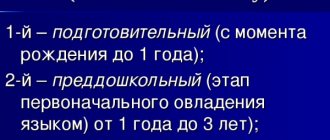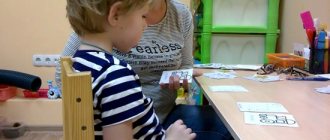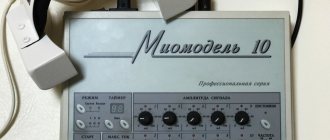Every parent knows how beneficial physical activity is for the development of young children. And there is no need to limit it: children must constantly run, jump, crawl, overcome obstacles, climb ropes or trees, ride a bicycle or scooter... With all this, in the baby’s daily routine there must be a place for gymnastics, during which the child performs exercises , perfecting your movements. For children under one year old, parents perform gymnastics, moving their arms and legs. But by the age of one year, children usually begin to walk independently, later they learn to squat and stand up, and can repeat simple movements after adults. We'll tell you what gymnastics should be like for children aged 1 year and older.
Improving skills
So, after a year, children actively master motor skills: they learn to run, jump, crawl under or over obstacles, climb heights, overcome stairs, swing on swings, slide down slides, walk on a log... But their movements, of course, are still awkward and uncoordinated, coordination and balance are very poorly developed. Therefore, from the age of one year until the baby is 3–4 years old, the task of adults is to select exercises that will help the little ones become dexterous and develop coordination of movements, and teach them how to maintain balance.
In addition, gymnastics for children aged 1 year and older helps:
- strengthen immunity;
- develop endurance;
- breathe correctly (which contributes to better saturation of organs and tissues with oxygen);
- feel your body in space;
- improve metabolic processes;
- strengthen muscles, ligaments, joints, skeleton;
- improve posture;
- normalize the functioning of the nervous system;
- improve digestion;
- normalize sleep;
- develop a sense of rhythm.
If during gymnastics your baby performs movements in a circle or square, he will also learn these simple figures. Turning to the sides, walking in different directions, will reinforce the concepts of “left-right”, “forward-back”. In the process of outdoor gymnastic games, the child develops courage, perseverance, self-confidence, and perseverance. So the value of gymnastic exercises is not limited only to improving physical performance.
What tasks should a teacher set when teaching children?
A teacher is the person who must, first of all, teach activity, improve mood, organize and teach organization. Having completed a full course of physical therapy, the student must not only improve strength, agility and other qualities, but also strive to develop independently. To be more precise, his parents should help him with this. He must agree to perform developmental exercises.
A well-designed plan will increase:
- strength;
- flexibility;
- dexterity;
- speed;
- reaction.
It is important that the baby does not lag behind his peers in these qualities and can feel comfortable. Sports and physical education can help him a lot with this. Naturally, by the age of 3-4, children are not yet making fun of each other, but lost time at an earlier age can affect further development. The difference between children will become more significant.
General rules
The main thing that parents should focus on when selecting exercises for children is that they match the baby’s skills and gradually increase in complexity as the child develops. That is, the movements should be accessible to him and easy to perform. At first it will be just walking, squatting, crawling, then they will add overcoming obstacles, climbing ropes, ropes, jumping, playing with a ball, hoop, toys, etc.
What else is important to know about organizing gymnastics classes with kids?
- The gymnastic complex should include 5-6 exercises affecting all muscle groups (arms, shoulders, legs, abs, back, neck), and they should be alternated.
- Exercises for the arms and legs can be done faster than for the torso.
- The child should breathe through the nose, without holding his breath.
- To make the lesson more interesting, the complex includes a couple of imitation exercises that can be combined into a story game.
- You cannot exercise on an empty stomach, or immediately after eating; you must wait about an hour.
- Gymnastics is carried out daily or every other day, from 5 to 15 minutes are allotted for this (after all, children at that age cannot concentrate for long and get tired very quickly).
- Exercises are repeated 3 to 5 times.
- If the weather permits, it is better to conduct classes in the fresh air (for example, while walking).
- The complex must include walking and breathing exercises.
- Kids tend to imitate, so movements in gymnastics can and should imitate the movements of animals, cartoon characters or fairy-tale characters.
- It is useful to use the material at hand (outdoors these are playgrounds, trees, stumps, pebbles, mounds, borders; at home - chairs, tables, carpets, pillows, etc.).
- If the child is tired or begins to protest or be capricious, it is better to stop the activity. They will not be of any use against the child's will.
- For exercise, a morning or evening walk is perfect. The main thing is that active physical exercises should not be carried out immediately after daytime sleep or less than 2-3 hours before bedtime.
Examples of exercise therapy for children 2 years old
In order to improve walking, you can use various exercises. If at this age the baby is still unsteady on his feet, then try to encourage him to move along the furniture. When he stands next to the sofa, start luring him with a bright toy, bringing it closer to him and away from him. You can repeat this exercise up to 4 times, depending on your interest.
If you have achieved the necessary progress, you can begin to complete more complex tasks. The first of these will be walking “on a narrow bridge.” To do this, you will need ropes or sticks, with the help of which the path will be built. At first its width will be 30 cm, but gradually it needs to be narrowed. The baby will have to walk along it without stepping on ropes or sticks, maintaining balance.
The next most difficult exercise is walking on an inclined path. To do this you will need a bench or board. One end of it is placed 20-30 cm higher than the other. The child, with the help of an adult teacher, must alternately rise and fall along the surface.
The following group of exercises helps develop a sense of balance
To complete the first task you will need a rocking horse. There is no need to make any special effort on the part of the student. An adult teacher or family member needs to gently rock the horse. This can also be done on regular swings and carousels.
Experienced specialists have one more effective exercise in physical education. It is very simple, but effective. Under the pretext of finding a toy, you invite the baby to climb onto the sofa. Further, the complex can be complicated by asking you to climb higher.
When should you not exercise?
Surely many people know that any exercise is contraindicated for children who have recently undergone a preventive vaccination. But this, it turns out, is far from the only reason why gymnastics will have to be cancelled.
There are a number of diseases for which gymnastics are prohibited:
- any conditions accompanied by fever and fever;
- various inflammatory lesions of the skin (including purulent ones), as well as muscles, bones, lymph nodes or subcutaneous tissue;
- atrophy;
- bone diseases, accompanied by pain and fragility;
- acute arthritis, tuberculosis of bones or joints;
- acute nephritis or hepatitis;
- rickets;
- congenital heart defects;
- hemorrhagic diathesis, hemophilia;
- active tuberculosis;
- large hernias (inguinal, umbilical, scrotal, femoral).
Sometimes we cannot “by eye” determine whether a child has a particular disease. Therefore, before starting active physical activities with him, consult your pediatrician.
Let's play gymnastics
The best way to organize gymnastics classes for young children is to turn them into a game, accompanied by fun music, songs, poems and imitations of various actions. So the little ones will be interested. The game is the best motivation for them.
For example, you can act out a funny children's poem (“Teddy bear”, “The bull is walking, swinging” or any other that describes the actions). Children can stomp like bear cubs, jump like little hares, jump like sparrows, bend their backs and stretch like cats, hum like trains, fly like airplanes, accompanying their movements with appropriate sounds...
It’s even more fun to act out a funny song (“In Africa, the mountains are this wide,” “Loaf,” “Dance of the Little Ducklings” and others).
There are also many fun nursery rhymes to motivate your child to get started. Examples of them can be found in children's books or made up yourself. It's not difficult, the main thing is motivation:
Babies, babies
They go out onto the site
They will be in order
And they will start charging.
Our kids will become
Be strong, be strong!
Gymnastic complexes for children should include:
- general developmental exercises (strengthening the abdominal and back muscles) – “Boat”, “Bicycle”, etc.;
- tasks to improve walking and running - outdoor simulation games (“Rain”, “Horses”, “Sparrows”);
- for the development of accuracy (“Skittles”, “Get into the basket, ball”);
- simple acrobatic exercises (overcoming small obstacles, quickly squatting and lifting);
- musical exercises that develop a sense of rhythm - accompanied by poems or songs.
Making a complex
Exercises for children become more difficult as they grow. If in a year these are very simple imitations and movements (squats, bends), then gradually they become more complicated. So, by the age of 2, a child can be offered the following version of gymnastics:
- walking up and down an inclined surface (board), the exercise can be accompanied by the poem “A bull walks, sways”;
- “Kitty” - steps and jumps in different directions to the poem “Cat on exercise”;
- “Snake” - crawling under a low stretched rope;
- “Basketball player” - throwing the ball forward from behind the head (at a distance of up to a meter);
- “Heron in the swamp” - stepping over “bumps” (balls);
- “Seal” – lifting the ball up in front of you, lying on your stomach;
- “Rock climber” - climbing a ladder up to 1.5 meters (1-2 times);
- imitation movements to relax the hands (to the poem “Our fingers are tired”).
By the age of 3, classes can become even more complex (but no less interesting):
- “Sentries on duty” - stepping over colored circles laid out on the floor;
- “Running horses” - running with a change of pace (up to 20 seconds);
- “Thrower” - throwing the ball with each hand in turn (target - at a distance of about a meter);
- abdominal exercise - lifting the torso (“the caterpillar is looking for breakfast,” for example, or “Vanka-Vstanka”), the legs are fixed by an adult;
- “Boat” - raising straight arms and torso from a position on the stomach;
- “Little Frog” - jumping with both feet over a rope or stick lying on the floor;
- walking with a change of support (on toes or heels) to the poem “A Heron Walks in the Swamp”;
- “Shake off snowflakes” - movements to relax the arms and legs.
So, in order to organize gymnastics classes with children after one year, it is important to take into account their age, physical skills, state of health and emotions, time of day, as well as the need for motivation. At the same time, it is important not just to play, use music or nursery rhymes, but also to inspire by your own example. Only then will the child consider gymnastics an integral part of life.
Morning exercises for children 2–3 years old (selection of play exercises)
Vera Gennadievna
Morning exercises for children 2–3 years old (selection of play exercises)
Physical education for children of any age should include gymnastics . Little fidgety 2-3 year olds are not always ready to do boring exercises , but if you turn the activity into a game, it will bring benefits and pleasure. Don't forget that physical activity with your child is an excellent way to spend time together and communicate. We suggest looking at examples of play gymnastics for young children .
Slowly demonstrate the movements yourself, slowly pronouncing the movements in words.
Play out each exercise with funny jokes, songs, sounds, using themes that are close and understandable to the child. Involve your favorite toys in the exercises . Praise your child for his efforts.
Charging time is approximately 5 minutes. It is enough for the child to learn 2-3 exercises . After mastering them, you can try others, that is, change the set of exercises approximately every week.
Complex "Butterfly"
Stand on your toes and stretch your arms up as you inhale. The butterfly woke up and stretched sweetly.
Lower your arms to your sides, moving them back, exhale, smile. Smiled at the sun.
Extend your arms to the sides, bend your elbows at shoulder level, fingers touching your shoulders. I spread my wings.
Bring your elbows in front of you, bring them back. One-two, one-two.
Tilt to the right, straighten up. I straightened my dress.
Tilt to the left, straighten up. One-two, one-two.
Walking turning into running. I flew to a flower to drink sweet juice.
Run and flap your arms like wings. And fluttering lightly, it circles over the grass. And the grass trembles merrily in the wind.
Sit down, clasp your legs with your hands and tilt your head forward. On the lawn a butterfly sat on a flower.
Stand with your hands behind your back. And she ate the pollen deliciously.
Repeat the squat. Appetizingly devouring as much as both cheeks
Stand up. And she washed down the dew from the sedge petals.
Hands on the waist, bending to the sides. I admired the reflection in the dewdrops. Oh, how beautiful! Just like in the picture!
Arms to the sides, wave your hands. Spreading its wings, it flew on.
Run in circles and flap your arms like wings. To the strawberry meadow, drink nectar, it’s sweeter there.
Stop, index finger to lips. "Shhhhh"
March in place. I took a large net in my hands and waited a little.
Jump, reach up with your arms, squeezing and unclenching your hands. Now jump, now jump, I caught a butterfly. Another jump, another jump, another caught.
Cup your hands like a ladle and blow on them. I blew on her wings, felt a little sad, then looked, then sighed
Stand on your toes, raise your arms up while inhaling. And then he let me go.
Lower your hands and exhale.
Hands up and down again.
Complex "Bunny"
Place the bunny in the middle.
Stand on your toes and stretch your arms up as you inhale. In the morning, bunnies woke up on the lawn. Hello red sun.
Lower your arms through your sides, moving them back. Hello clear skies!
Right hand to the side. Hello Christmas tree,
Left hand to the side. Hello stump!
Lean forward and straighten up. Hello, hello, new day!
March on the spot. The bunnies walked through the forest, one-two, one-two, they found a new bunny, one-two, one-two.
Bend forward. Not one was lazy, he bowed to the bunny from the waist.
Tilt to the right, tilt to the right, tilt forward, straighten up. Hello, hello, eared friend.
Hands on the belt, nod your head. The new bunny nodded to them.
Turns the head to the right, left. He turned both cheeks: smack, smack, smack, smack.
Sit down, clasp your legs with your hands, tilt your head forward, touch the floor with your fingers, squeezing and unclenching your fists. A bunny in a field deftly pulls a carrot.
Stand up and repeat the squat. Whoops, whoops, whoops, whoops, it’s hard to pick carrots.
Jump, hands on your belt. Little bunnies and gray naughty girls are jumping.
Jump, wiggle your ears
on top of the head. They spin their ears sensitively. Oh, the bears are coming towards us. We won't run away, they won't scare us.
Squat down. Let's hide under the spruce trees so we don't get eaten.
Get up and run in a circle. And the bears will all leave, the bunnies will get up and run.
Walk in the other direction.
Stand on your toes, raise your arms up as you inhale and lower as you exhale.
Hands up and down again.
Complex "Birds"
Flapping your arms like wings. Birds can have fun all day, all day long.
Stand on your toes and stretch your arms up as you inhale, lower them. And they are not too lazy to be lazy in the sun, they are not too lazy.
Hands on your belt, turn your head to the right, to the left. Sing funny ditties chik-chirik, chik-chirik, so that the cuckoos and the sandpiper and the sandpiper will listen.
Raise your arms to the sides, lower them and bring them back. Birds can fly with the clouds, fly
Repeat. To wave your wings to mom, to wave.
Raise your arms up to the sides. How tired our birds will be of singing, flying, singing, flying.
Sit down, clasp your legs with your hands, tilt your head forward, and knock on the floor with your fists. They will sit down and peck at some sweet wheat.
Repeat the squat. The same words.
Continue banging your fists on the floor. Peck, peck, peck, how I love grains.
Jump with your arms up. They pecked and flew up to the skies, to the skies. And then they rushed headlong straight into the forest, straight into the forest.
Hands on the waist, tilts to the right and left. Birds can have fun until the morning, until the morning.
Walk in place, bending slightly, as if we were sneaking. Just, chu, a cat is sneaking
Run in circles. Run away, kids.
Walk in the other direction.
Stand on your toes, raise your arms up as you inhale and lower as you exhale.
Hands up and down again.
Complex "Kitten"
Get a toy cat. The cat woke up before everyone else. Raised his red tail in a column.
Place it in the middle, bending over with a straight back and straight knees. His back stuck out with a hump
Stand on your toes and stretch your arms up as you inhale, lower them. And the whole cat's mouth yawns.
March on the spot. Day and night, a black cat waits for a mouse near the hole. He doesn't sleep or walk
Sit down with your hands touching the floor between your knees. Everyone sits and watches. He doesn’t take his eyes off the mink.
Stand up, spread your arms to the sides. Only the mouse doesn't come.
Sit down with your hands touching the floor between your knees. Because he doesn't live
Stand up. This is my third year in this hole.
Hands on the waist, tilts left and right. Resourceful and flexible, the cat walks between the posts. In order, without mistakes, he will go around all the racks. The cat likes work, probably because he really doesn’t want to be locked up.
March on the spot. The cat is hunting today, catch birds in the swamp.
Sit down, “ears”
press on the top of the head. He pressed his ears, hid, and lay down.
Jump and clap your palms, 4 times. Jump here and jump here, the birds flew away, yes! I missed, as luck would have it, only the birds were lucky.
March on the spot. A cat walked around the yard, the cat got its feet dirty. They don’t let the cat into the house, their feet get dirty all over.
Hands on your waist, place your right foot forward on your toes, then on your heel. All four of her heels leave imprints.
Repeat with the other leg. What about the poor cat? You need to wash her feet.
Run in a circle, then walk in the other direction.
Stand on your toes, raise your arms up as you inhale and lower as you exhale.
Hands up and down again.
You can come up with your own set of exercises .
Each exercise should be done for about 10-30 seconds or 2-4 times.
The structure of the lesson is something like this:
1. Breathing exercise
2. Walking/running
3. One exercise from each complex (one exercise for the shoulders , one for the arms, one for the torso and one for the legs).
Breathing exercise.
"Get some sunshine"
. Hold a yellow balloon in your hands and ask the child to get the sun. He will stretch his arms up and rise on his toes.
Another option is “Hello, sunshine!”
Stand up straight, arms along your body. As you inhale, arms up, “reaching towards the sun”
, while exhaling, lower it. 3 times.
Walking/running (you can use Zheleznov songs)
Walk freely around the room, waving your arms (large amplitude)
. Possible with jumps. March in place.
Speed up your walking. Run around (you can catch up, you can run between placed objects - good for coordination).
“The bear is walking with a clubfoot”
.
"A Heron Walks in the Swamp"
. Walk with your knees high.
"Catching Butterflies"
. Move around the room in any direction and clap your hands, imitating catching butterflies.
"Locomotive"
.
The child holds on to his mother's legs. We imitate a steam locomotive that moves around the perimeter of the room (we voice it - chug-chug)
.
"We walk along the path"
. Walk on a scarf about 15 cm wide.
Exercise “Step over the handkerchief”
(the mother holds the handkerchief by both ends, and the child steps back and forth)







